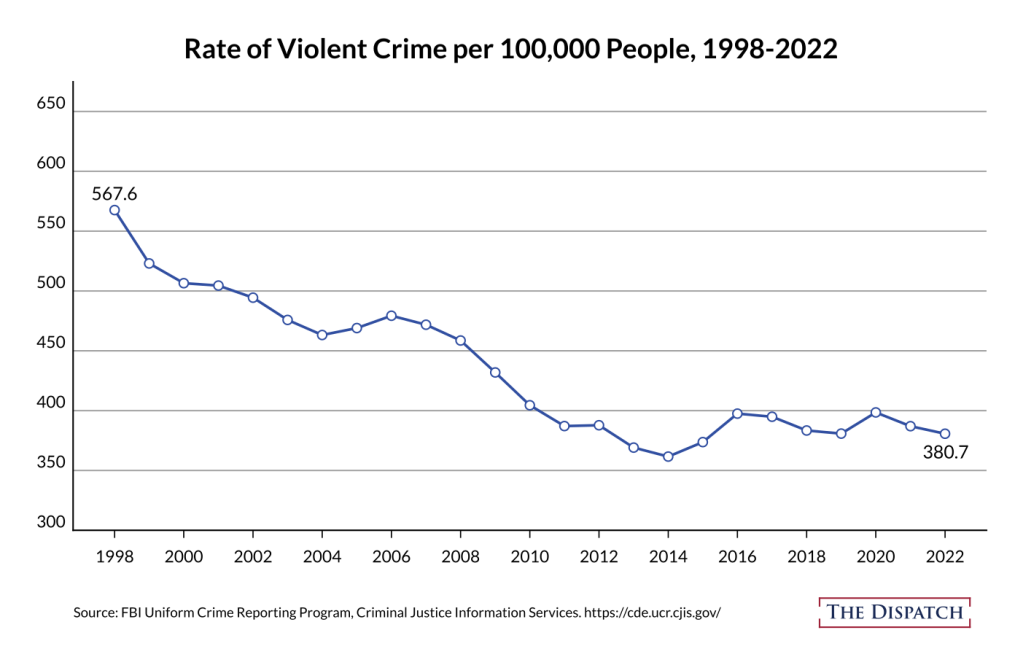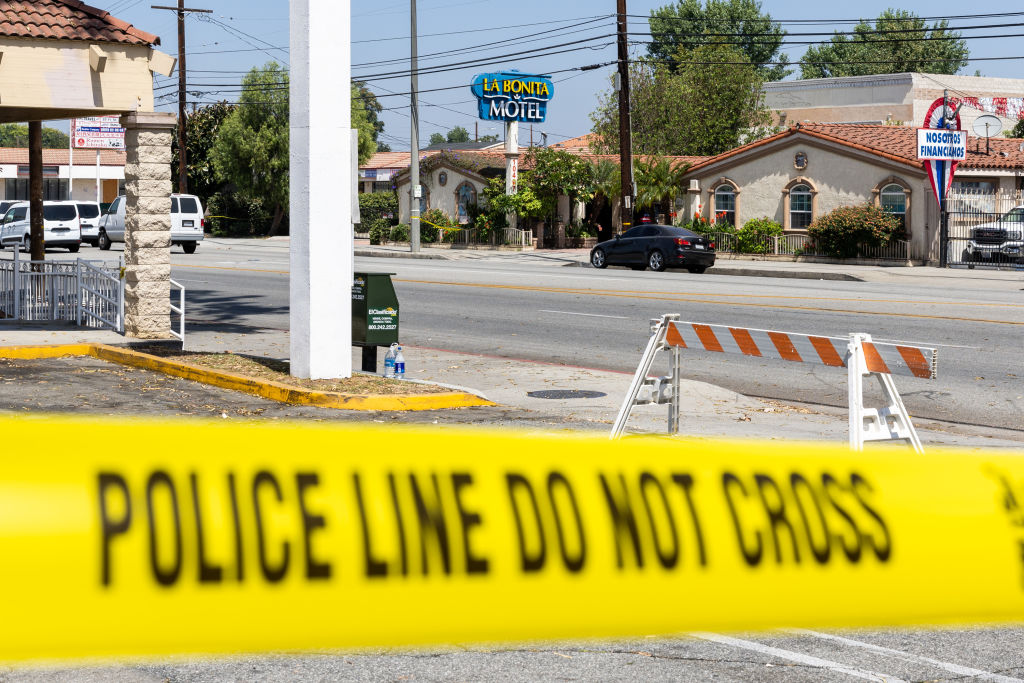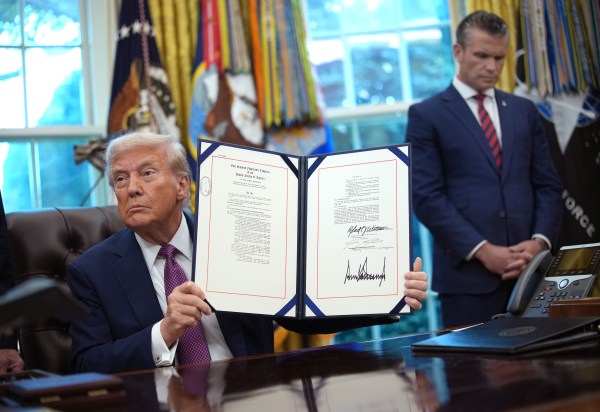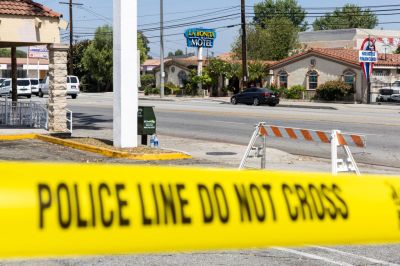Countless polls suggest that Americans are increasingly concerned about rising crime in the United States. A recent Gallup poll indicates 77 percent of Americans believed that crime had worsened in 2023. Politicians have declared that crime has skyrocketed in the past three years under the Biden administration. However, reliable data released last month by the FBI suggests otherwise.
So why the persistent perception that crime is rising? Perhaps it is rooted in the raw numbers of violent crime, increases in thefts, revolving door justice systems in our population centers, and rising number of attacks on law enforcement sworn to protect us.
The National Incident-Based Reporting System (NIBRS) is our nation’s most often cited uniform crime report card. The data at first glance informs that violent crime in 2023 dropped 6 percent, property crime fell by 4 percent, homicides decreased by 13 percent, and aggravated assaults dropped 5 percent. These numbers appear positive if taken in the vacuum of 2023.
In March, the Biden administration released a statement celebrating that 2023 “had one of the lowest rates of all violent crime in more than 50 years and the murder rate saw the sharpest decrease in history.” The president said his administration is “making it a reality” that citizens should feel safer in their communities.
So why don’t they?
Declaring crime rates in 2023 to be “one of the lowest rates” in “more than 50 years” would be an astonishing statistic if it were an honest evaluation of the data. The problem is the claim fails, perhaps intentionally, to take into account a number of factors that fuel the persistent perception that crime is on the rise. With any statistical comparison, such as the one made by Biden, it is important to look under the hood of data sets to validate such claims.
Understanding the data source.
NIBRS and Uniform Crime Reporting (UCR) data are the primary sources of crime data in the U.S. Compiled by the FBI’s Criminal Justice Information Services (CJIS), the 18,000 or so law enforcement agencies from around the country send their crime data to CJIS annually. This data is curated by the sending agency and is admittedly incomplete. Crime data is measured both in raw numbers and per 100,000 persons. Regardless of the inconsistencies, UCR and NIBRS remain the gold standard of crime data in the U.S. But some analysis to Biden’s claims is warranted, especially given the persistent perception that crime is rising.
To start, NIBRS and UCR data does not go back 50 years, so scoring the claim on that basis would be nearly impossible. Moreover, the 2023 quarterly data is not the full complement of data compiled in the annual data sets, which is only as current as 2022. Arbitrarily examining the last 25 years will suffice. Also, in fairness to the president, keep in mind that he cited the “crime rate” and not the raw number of violent criminal offenses. It’s a distinction with a huge difference and possibly the foundation of the persistent perception that crime is rising.
Looking at the numbers.
In 1998 (25 years’ worth of data ago), the violent crime rate was 567.6 per 100,000 persons, the highest rate in the last quarter century. By comparison, the same FBI data source indicates that the violent crime rate in 2022 was only 380.7 per 100,000 persons, or about a one-third reduction in the violent crime rate in that timespan. Any visual evaluation of the FBI graph below might indicate that we are safer now since the crime rates in America have steadily declined over the past 25 years.

This is where looking under the hood of the data becomes useful for real crime analysis. In fact, the raw number of crimes is much higher.
In 1998 there were 119,724 violent criminal offenses reported. Compare that to 2022, when there were 951,270 such offenses reported. That is a staggering 695 percent increase in violent criminal offenses over that 25-year period. There were approximately 894,000 violent criminal offenses reported in 2023.
Biden stated that “the prior [Trump] Administration oversaw the largest increase in murders ever recorded” in 2020. It is true that the spike in homicides, and nearly every other criminal category, rose dramatically that year. Biden’s statement continues by proclaiming that homicides “saw the sharpest decrease in history” in 2023, falling by 13 percent.
However, recently published data informs us that in the three years Biden has been president there were 22,536 murders in 2021, 21,156 murders in 2022, and approximately 18,400 murders in 2023, or 62,098 in a three-year period. Conversely, the four years of the Trump administration saw 18,206 in 2017, 16,937 in 2018, 16,952 in 2019, and 22,414 murders in 2020, or a total of 74,509. Under Trump, the country averaged 18,627 murders per year. Under Biden, the country is averaging 20,700, or more than 10 percent more murders per year.
Moreover, if 2020 is stripped from the data set, Joe Biden has presided over the three deadliest years in American history … and it’s not even close. The celebrated 2023 was one of the most violent years in American history. Violent crime offenses are generally higher under Biden as well. For instance, in 2020 (the most violent year during Trump’s administration) there were 673,812 violent crime offenses reported. By comparison, Biden’s storied 2023 saw nearly a quarter million more violent criminal offenses.
Feeling safer?
The persistent perception about property crimes
Curiously, the Biden statement did not mention thefts and property crimes at all. Perhaps that’s because there are only so many times a man can ask members of the public to disbelieve their lying eyes. We have seen the drug stores looted, convenience stores robbed, department stores cleaned out, and businesses ruined by the brazen burglaries and thefts streamed live before us over the past several years.
In support of our lying eyes, NIBRS data indicates that in 2023 property crime (thefts, larceny, burglary, etc.) is up 3 percent in major cities. Motor vehicle theft is up 11 percent nationwide. In 2022, property crimes rose almost 7 percent, the first time the overall property crime rate rose nationally since 2000 and only the second time since 1991.
No wonder Biden didn’t mention it.
A decline in arrests means fewer consequences.
Society would hope that as the raw number of criminal offenses rise or remain at historically high levels, the nation’s arrest levels would rise accordingly. Society would also hope that the government would invest in law enforcement resources commensurate with the crime threat. Unfortunately, and to no fault of law enforcement, hope is not much of a crime fighting strategy.
In 2022 there were 2,076,644 arrests in the U.S. In 2021, there were 1,762,945. By comparison, there were more arrests made during Trump's administration with the exception of 2020, when there were 2,051,465. In fact, law enforcement made more arrests in 2020—when the nation was literally locked inside—than in all of 2021. Law enforcement averaged more than 2,731,573 arrests per year during the Trump administration, due in no small part to aggressive law enforcement initiatives and prosecutors. Since then, there has been an average of only 1,919,794 arrests per year, which is a 30 percent decrease. Fewer arrests equal fewer prosecutions, which equal fewer consequences for criminals.
There are several plausible explanations for this decline in consequences.
Impacts on policing.
Major metropolitan areas moved to defund the police after the George Floyd murder. Politicians weakened the protective policing posture of their communities intentionally, made everyone less safe, and only recently discovered what a self-defeating policy this has been. Defunding the police at any level is Chapter 1 in the “Book of Bad Ideas.” Fewer police mean fewer arrests. That’s just math.
In the wake of the “defund the police” movement, violence against law enforcement continues to rise at untenable levels. The National Fraternal Order of Police reports that 2023 was the most violent year endured by law enforcement with 378 officers shot, a 17% increase over 2020, and the number of officers shot in the line of duty has been higher on Biden’s watch than at any time in history. In 2020, there were 60 officers injured or killed in ambush-style attacks on law enforcement. By comparison, that number has more than doubled each year of the Biden Administration with 133 in 2021, 126 in 2022, and 138 in 2023. The result of this unsustainably high violence on the brave men and women of law enforcement is poor retention rates, poor recruitment rates, and under-policing of those communities that need policing the most.
Conjoined with those two explanations is the phenomenon of elected prosecutors who refuse to enforce criminal laws, release repeat offenders without bail, and show little interest in prosecuting crimes. And these prosecutors are located in America’s largest cities, all being decimated by high crime, such Kim Foxx in Chicago, Larry Krasner in Philadelphia, George Gascón in Los Angeles, just to name a few. Most of these prosecutors have collectively received millions in political contributions from organizations funded by or affiliated with George Soros, a malignant stain on public safety. The Soros-backed, revolving-door criminal justice system these weak prosecutors tout is just a step above not having one at all.
The persistent perception concludes correctly.
So, the question remains … why does the perception that crime is rising persist when recent data, celebrated by the Biden administration and parroted in liberal media, suggests it went down last year?
It’s your lying eyes.
Crime is still higher than it has ever been. It seems nonsensical to preside over record high crime in 2022 and then take a victory lap in 2023 when it trends slightly downward.
The raw data is clear. There were fewer crimes being committed during the Trump administration as compared to the Biden administration … and it’s not even close. The perception persists because of incredibly bad policies, like defunding the police. The perception persists because of soft prosecutors, regrettably weak bail reforms, deadly increase in violence against law enforcement, and because arrests are down while crime is high.
President Biden celebrated his 2023 crime stats as “good news for the American people.”
But for all the data to the contrary, I would agree.






Please note that we at The Dispatch hold ourselves, our work, and our commenters to a higher standard than other places on the internet. We welcome comments that foster genuine debate or discussion—including comments critical of us or our work—but responses that include ad hominem attacks on fellow Dispatch members or are intended to stoke fear and anger may be moderated.
With your membership, you only have the ability to comment on The Morning Dispatch articles. Consider upgrading to join the conversation everywhere.